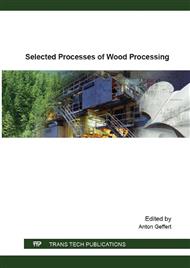p.25
p.31
p.38
p.44
p.50
p.59
p.65
p.77
p.82
Engineering Approach for Computation of the Energy Consumption Needed for Defrosting and Subsequent Heating of Frozen Wood Chips
Abstract:
An engineering approach for the calculation of the specific mass energy consumption, which is needed for defrosting and the subsequent heating of the frozen wood chips above the hydroscopic range, (in kWh·t-1), has been suggested. Equations for easy calculation of have been derived, depending on the wood moisture content u, on the fiber saturation points of the wood species at 20 °C and at –2 °C (i.e. at 293.15 K and at 271.15 K), and respectively, on the initial chips’ temperature, T0 , and on the final temperature of the heated after their defrosting chips, T1.For the calculation of the according to the suggested approach and equations a software program has been prepared in MS Excel 2010. With the help of the program calculations have been carried out for the determination of the energy consumption , which is needed for defrosting and subsequent heating of oak, acacia, beech, and poplar frozen chips with moisture content in the range from u = 0.4 kg·kg-1 to u = 1.0 kg·kg-1, initial temperature t0 = –20 °C and t0 = –10 °C until reaching of the chips‘ mass temperature of t1 = 80 °C, t1 = 100 °C, and t1 = 120 °C at the end of the heating.
Info:
Periodical:
Pages:
50-56
Citation:
Online since:
April 2016
Keywords:
Price:
Сopyright:
© 2016 Trans Tech Publications Ltd. All Rights Reserved
Share:
Citation:


